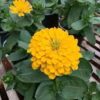**Harnessing the Healing Power of Chamomile Flowers: Traditional Herbal Remedies and Their Uses**

**Introduction:**
For centuries, chamomile flowers have been revered for their medicinal properties and therapeutic benefits in traditional herbal medicine practices around the world. Known for their soothing aroma and gentle yet potent healing effects, chamomile flowers have been used to treat a wide range of ailments and promote overall health and well-being. In this comprehensive guide, we’ll explore the various ways chamomile flowers are used in traditional folk medicine and how you can harness their healing power to support your health naturally.
**Chapter 1: The Medicinal Properties of Chamomile Flowers**
Chamomile flowers contain a rich array of bioactive compounds, including flavonoids, terpenoids, and antioxidants, which contribute to their medicinal properties:
– **Anti-inflammatory:** Chamomile has anti-inflammatory properties that can help reduce inflammation and swelling, making it beneficial for conditions such as arthritis, sore muscles, and skin irritations.
– **Antispasmodic:** Chamomile’s antispasmodic effects help relax muscles and calm the nervous system, making it useful for relieving menstrual cramps, gastrointestinal discomfort, and tension headaches.
– **Antioxidant:** The antioxidants in chamomile help neutralize harmful free radicals in the body, protecting cells from damage and reducing the risk of chronic diseases such as heart disease and cancer.
– **Sedative:** Chamomile has mild sedative properties that can promote relaxation and improve sleep quality, making it a popular remedy for insomnia and anxiety.
**Chapter 2: Making Chamomile Infusions and Teas**
One of the simplest and most popular ways to enjoy the benefits of chamomile is by making infusions and teas:
– **Chamomile Tea:** Steep dried chamomile flowers in hot water for 5-10 minutes to make a fragrant and soothing herbal tea. Enjoy it plain or sweetened with honey for added flavor.
– **Chamomile Lemonade:** Combine chamomile tea with freshly squeezed lemon juice and honey for a refreshing and healthful alternative to traditional lemonade.
– **Chamomile Infusions:** Infuse chamomile flowers in oil, vinegar, or alcohol to extract their medicinal properties for use in topical applications such as massage oils, herbal baths, or tinctures.
**Chapter 3: Topical Applications for Skin and Hair Care**
Chamomile is also valued for its skin-soothing and hair-nourishing properties:
– **Chamomile Compress:** Apply a warm chamomile compress to inflamed or irritated skin to reduce redness, itching, and inflammation. This can be especially helpful for conditions such as eczema, sunburn, or diaper rash.
– **Chamomile Facial Steam:** Add dried chamomile flowers to a bowl of hot water and inhale the steam to open pores, cleanse the skin, and promote relaxation. Follow with a gentle facial massage using chamomile-infused oil for added hydration and nourishment.
– **Chamomile Hair Rinse:** Rinse your hair with chamomile tea after shampooing to soothe the scalp, enhance shine, and lighten blonde or highlighted hair naturally.
**Chapter 4: Culinary Uses of Chamomile Flowers**
In addition to their medicinal applications, chamomile flowers can also be used in culinary creations:
– **Chamomile Syrup:** Make a simple syrup infused with chamomile flowers to sweeten beverages, desserts, or fruit salads. Simply simmer equal parts water and sugar with chamomile flowers until the sugar dissolves, then strain and cool before using.
– **Chamomile Honey:** Infuse honey with chamomile flowers to add a subtle floral flavor to teas, toast, or yogurt. Place dried chamomile flowers in a jar, cover with honey, and let steep for a week before straining and storing.
– **Chamomile Baked Goods:** Add dried chamomile flowers to baked goods such as cookies, cakes, or scones for a delicate floral flavor and aroma. Simply grind the dried flowers into a fine powder and incorporate them into your favorite recipes.
**Chapter 5: Combining Chamomile with Other Herbs and Ingredients**
Chamomile can be combined with other herbs and ingredients to enhance its therapeutic effects:
– **Lavender Chamomile Sleep Pillow:** Fill a small muslin bag with dried chamomile flowers and lavender buds to create a calming and aromatic sleep pillow. Place it under your pillow or near your bed to promote relaxation and restful sleep.
– **Chamomile Calendula Salve:** Infuse olive oil with dried chamomile flowers and calendula petals to make a soothing and healing herbal salve for minor cuts, burns, or skin irritations. Add beeswax and essential oils for additional skin-nourishing properties.
– **Chamomile Ginger Digestive Tea:** Combine dried chamomile flowers with dried ginger root and peppermint leaves to make a soothing and digestive herbal tea. Drink it after meals to aid digestion and alleviate bloating or indigestion.
**Chapter 6: Precautions and Considerations**
While chamomile is generally safe for most people, there are a few precautions to keep in mind:
– **Allergies:** Individuals with allergies to plants in the Asteraceae family, such as ragweed, marigolds, or daisies, may also be allergic to chamomile and should avoid its use.
– **Pregnancy and Breastfeeding:** Pregnant or breastfeeding women should consult with a healthcare professional
before using chamomile products, as their safety during these periods is not well-established.
– **Medication Interactions:** Chamomile may interact with certain medications, including blood thinners, sedatives, and anticoagulants, so it’s important to talk to your doctor if you’re taking any medications.
**Chapter 7: Conclusion**
In conclusion, chamomile flowers are a versatile and potent herbal remedy with a long history of use in traditional folk medicine. Whether enjoyed as a soothing tea, applied topically to the skin, or incorporated into culinary creations, chamomile offers a multitude of health benefits for the body, mind, and spirit. By exploring the various ways chamomile can be used in daily life, you can harness its healing power to support your health and well-being naturally, one cup of tea or homemade remedy at a time.
**References:**
[Insert references here]
**Disclaimer:** This article is for informational purposes only and does not constitute medical advice. Individuals with specific health concerns or conditions should consult with a qualified healthcare professional before using chamomile or any other herbal remedies.

